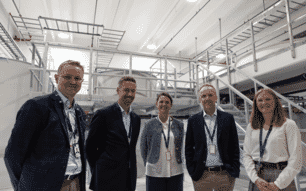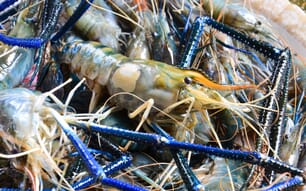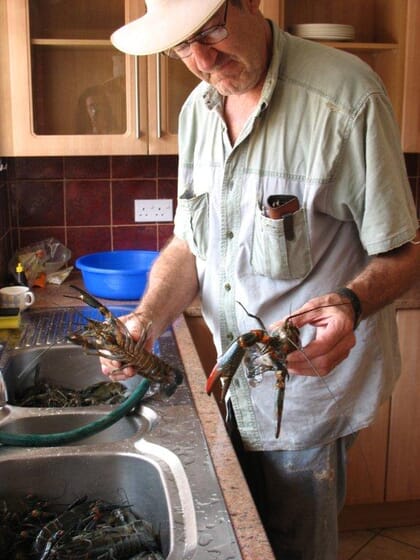
Piers diversified to cultivating red claw crayfish in his hatchery, which led him on a journey of discovery about the benefits of naturally occurring zooplankton as an effective feed for juveniles © Adrian Piers
Poor survival and slow growth during the initial life cycle stage – from hatching to juvenile – are key issues with many aquacultured species, particularly those that demand live feeds before being trained and weaned onto commercial pelleted diets. This usually necessitates the establishment of costly and management-intensive facilities within hatcheries, to ensure the needs of these species are met.
Traditionally zooplankton are produced in vats and/or Artemia (brine shrimp) are used, with the former usually being themselves fed by dedicated phytoplankton production. This adds another separate sub-system and level of complexity to the operations and demands a high level of technical management and control. Inadvertent contamination of the cultures is a perennial problem and is usually an indicator of poor planning, ineffective protocols to prevent such contamination, and poor management.
Besides the additional expenses of hatchery construction and staff costs, these systems also suffer from limitations due to the cyclical batch nature of their production. With a long chain of procedures such as this, any break in continuity will inevitably cause unwanted reverberations down the line. To overcome this many operators oversize their seed production systems to create added redundancy and better reliability, which adds extra expense.
Ideally, a reliable continuous flow of live feed is what is needed, tailored to the requirements of the main crop, and without undue wastage of time and resources.
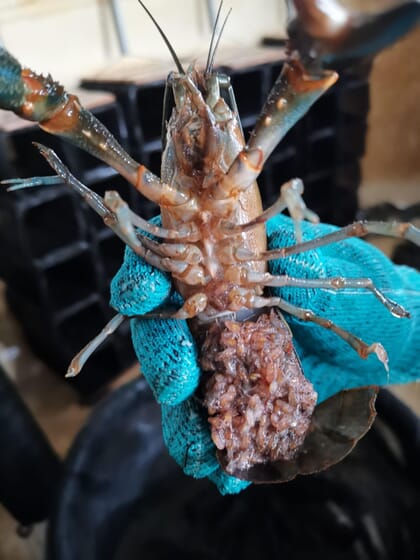
Piers stocked his hatchery tanks by collecting berried female red claw crayfish from a broodstock pond © Desmond Chow
Many limnological studies of plankton communities in natural water bodies show us these organisms are part of a dynamic ecosystem that changes, sometimes drastically, over time. From these surveys we have learned that there is a phenomenon known as succession, where a particular species dominates the zooplankton mix temporarily, eventually to be replaced by another, which then itself is displaced, and so on. Although the factors that influence this are numerous, it has been shown that seasonality, water chemistry, availability of nutrients and predation can all have substantial effects.
Historically, ornamental fish enthusiasts pioneered the collection of live feeds, mainly from wild sources, to feed their fish, with Daphnia (water flea) becoming a cultivated staple of the hobby. This has mostly worked well, but some limitations have since become apparent. Firstly, the size of the prey species does not always match the gape of the fish being cultured, making large zooplankton such as Daphnia inedible to very small fry immediately after hatching. Secondly, the nutrient profile is not always ideal, and although techniques of bio-enrichment are possible, and have been well explored, from a commercial point of view, this only adds another layer of complexity to the process. Key features of most successful and profitable livestock production systems are the use of simple and, by extension, reliable technologies that can be scaled up to provide economies of scale.
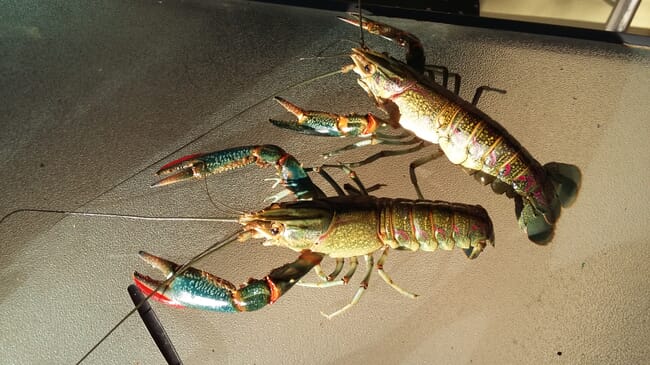
Piers diversified to farming red claw crayfish after years of mainly cultivating tilapia at his farm in Swaziland © Adrian Piers
Low cost, low maintenance
Some years ago I decided to diversify the species being farmed on my own aquaculture establishment. Tilapia were the main species being cultured at the time, in earth ponds, so growout and production facilities were already in place. However, with ponds of nearly one hectare in size, the initial numbers of stock of the new species acquired would not be sufficient to adequately bring the stocking density up to the required level. To achieve this, a rapid stock multiplication strategy was required.
My fish farm was situated in the IYSIS sugar estate at Tshaneni in Swaziland where a weir and canal system had been developed some time previously, and the sugar company had changed over from sprinkler irrigation to furrow irrigation, leaving a pumping station unused. It was decided to repurpose this facility as a hatchery, to which it was well suited, consisting of a large concrete tank, 20 by 20 by 6 metres, with water being supplied from the main irrigation canal system and a pumphouse built over a portion of this tank to originally house the sprinkler irrigation pumps.
Tanks of 60 by 30 by 20 cm were installed in the pumphouse, each with an individual water supply from a submersible pump in the large tank below, and an overflow directly onto the floor, which then drained back into the main tank. This provided more than adequate oxygenation for the system, which initially was the major objective.
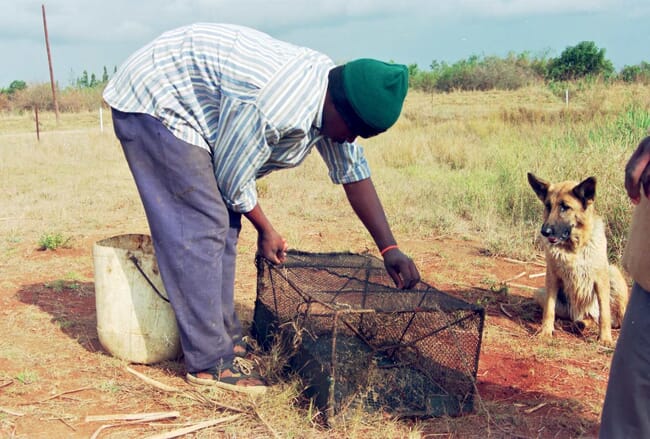
Once the crayfish eggs had hatched, Piers returned the female crayfish to the breeding pond for further mating © Adrian Piers
The species being cultivated, red claw crayfish (Cherax quadricarinatus), is known to tolerate quite low oxygen levels and accept powdered first feed, so this was provided. However, from the literature and research – done mainly in Australia – it had also been clearly demonstrated that access to live feed was very beneficial to their growth and survival. In these Australian trials live zooplankton were initially used, but later discontinued due to contamination. These were replaced by frozen zooplankton, to ensure no living organisms were included. While this was satisfactory from a nutritional point of view, especially with predatory finfish, they often need the movement of the prey species to trigger a proper feeding response.
The large concrete tank was supplied with raw water abstracted from a river by a weir and canal, and it was observed that naturally seeded phytoplankton and zooplankton had established themselves in this tank. Initially this was of some concern, as there was the possibility of predatory insects, specifically of the order Odonata (dragonflies), whose nymphs are extremely efficient predators of newly hatched fish fry. However, as the zooplankton were considered beneficial, and the fact that the cultivated species itself was known to be highly susceptible to insecticides, this ruled out chemical treatment of the water. To preclude the possibility of adult dragonflies laying eggs in this tank, a netting material with apertures small enough to exclude the adults was used to cover the tank.
Operations
Stocking the small tanks was done by collecting berried females from a broodstock pond with conventional crayfish traps. Once the crayfish eggs had hatched, and the juveniles were free living, the females were returned to the breeding pond for further mating. The juveniles were held subsequently for approximately six weeks, by which time they were large enough to avoid predation – especially by the African clawed frog (Xenopus laevis), which was widespread in the area – and stocked into growout ponds.
As this crayfish species is not a synchronous spawner (it will spawn year-round in suitable conditions), and has small brood sizes – analogous in many ways to tilapia, producing the required numbers of stocking juveniles in cohorts – batch harvesting, and pond drainage at the end of a cycle were important aspects.
As this was a commercial operation and not a serious scientific study, only basic data were collected. At first the powdered feed was envisaged as the main source of nutrition, however on observing the zooplankton in the main tank it was decided to try and enhance this as a supplementary source. To this end, organic manure was added, along with agricultural lime and mono ammonium phosphate (MAP). The increase in observable zooplankton was considerable and reflected in dramatically improved survival of the crayfish. Prior to this intervention 40 percent survival was the norm, calculated from an average brood size – this increased to approximately 70 percent.
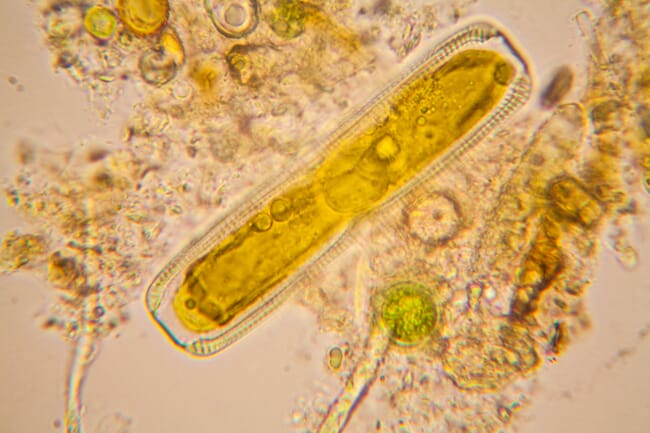
The precise zooplankton species was never formally identified by Piers, but the clear green emerald colour of the water in the main tank signified a dominant diatom bloom © Shutterstock
Over time other modifications were also introduced to fine-tune the system. One worthy of special mention was the installation of an underwater light immediately adjacent to the submersible pump. To verify this was actually improving the harvesting of the zooplankton, the delivery side of this pump was disconnected and filtered through a fine mesh plankton net occasionally and for a range of time intervals, with and without the light switched on. It was obvious that the yield of zooplankton had almost doubled through the use of the lamp.
No effort was made to identify the zooplankton to species level. Cladocerans, copepods and rotifers were all observed in the samples in varying proportions. Water quality was monitored to ensure adequate oxygen levels, which remained well within the best range of the species, and some experimentation was done with the amounts of nutrient inputs to determine, by trial and error, the quantities best suited to the system. As a guide, a clear green emerald colour (usually signifying a dominant diatom bloom) of the water in the main tank was used as a primary indicator.
Relevance and reliability
Many cultured aquatic species are chosen by multiple criteria, such as market acceptability and price, and/or avoided due to difficulty and complexity of the production process. While the technology to spawn many of these fish is known and understood, the capital cost and the mortality in the juvenile rearing stage is an impediment to the uptake of culture, especially by resource-poor small-scale farmers. With a simplified reliable system for live feed such as this, that can reliably function to remedy this situation, perhaps more interest will be shown in high value species, particularly for export markets.

